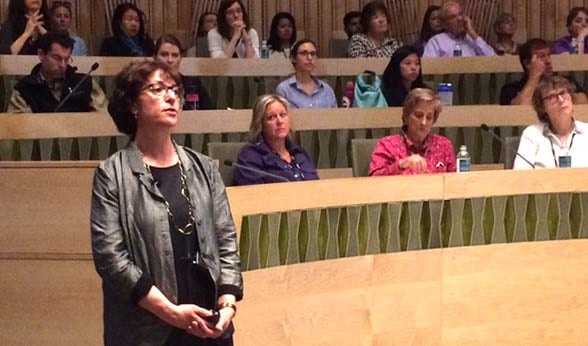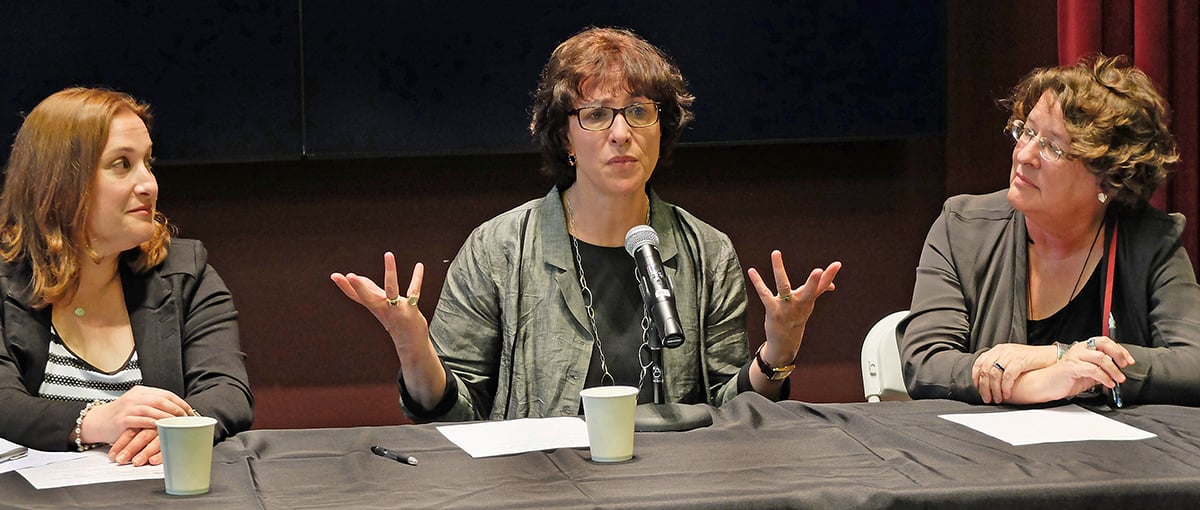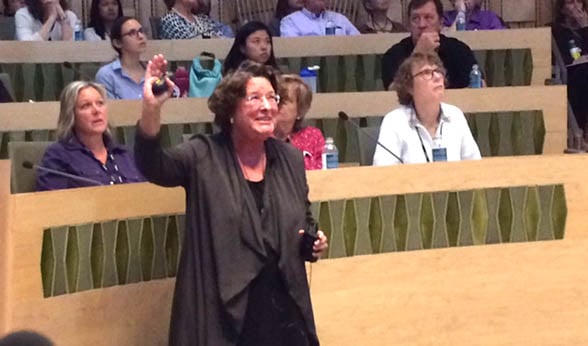One of history’s darkest periods – Germany in the 1930s and 1940s – took root during a propaganda-fueled march toward what were deemed imperative public health measures. The Nazis’ quest to create an “Aryan super race” led to thousands of innocents being killed, maimed and tortured.
 Tessa Chelouche, MD, co-director of the Maimonides Institute for Medicine, Ethics and the Holocaust, talks about the Nuremberg Doctors Trial.
Tessa Chelouche, MD, co-director of the Maimonides Institute for Medicine, Ethics and the Holocaust, talks about the Nuremberg Doctors Trial.
This relentless pursuit, marked by a perversion of medical ethics, ultimately ended in the conviction of a handful of key players at the Nuremberg Doctors’ Trial. The 70th anniversary of the trial, where 23 Nazi physicians and administrators were brought to justice for heinous crimes against humanity, was remembered during a recent program at the CU Anschutz Medical Campus.
[cucalloutbox align="right" color="" class="" size=""]
ANNUAL PROGRAM
Matthew Wynia, MD, MPH, director of the CU Center for Bioethics and Humanities, said the annual Holocaust Genocide and Contemporary Bioethics Program was strengthened this year by a partnership with the Maimonides Institute for Medicine, Ethics and the Holocaust. The partnership allowed the program to bring in speakers from around the world, making it a “unique and important event for the entire university community.” Other contributions included a generous grant from the M.B. Glassman Foundation as well as from Dr. William Silvers. Wynia noted that the annual program, for the first time, touched all four CU campuses
[/cucalloutbox]
A capacity crowd filled the Gossard Forum in the Fulginiti Pavilion to hear two experts on the landmark trial – Tessa Chelouche, MD, a physician and educator in Israel, and Susan Miller, MD, MPH, a research chair at the Houston Methodist Research Institute – speak on “Healing by Killing: Nazi Doctors and Modern Medical Ethics.” A panel also discussed the “Legacies and Lessons for Today’s Health Professionals” in a session after the lunch program.
Roots of cruelty precede Third Reich
In their talk, Chelouche and Miller gave chilling accounts of how leading physicians were behind the sterilization, euthanasia and human-experiment programs of that era. They also explained how the atrocities that came to light during World War II had roots that extended long before – and well beyond – the Third Reich, and they reverberate to this day.
A eugenics movement spread across the industrialized world in the early 20th century, including the United States, where sterilization laws were passed in more than 30 states. In the U.S., about 64,000 to 70,000 people – deemed by the medical profession as unfit to reproduce – were sterilized against their will, Chelouche said.
Hand in hand: Doctors and politicians
In early 20th century Germany, the “racial hygiene” movement grew and influenced Adolf Hitler, “giving him a scientific legitimacy for his racist political theories.” Fifty percent of German physicians joined the Nazi party, so “this wasn’t about a few crazy, mad doctors,” Chelouche said.
 Talking on a panel that explored Nuremberg's "Legacies and Lessons for Today's Health Professionals" are, from left, Stacy Gallin, founder and director of the Maimonides Institute for Medicine Ethics and the Holocaust; Tessa Chelouche, co-director of the Maimonides Institute; and Susan Miller, the GIM Research Chair at the Houston Methodist Research Institute.
Talking on a panel that explored Nuremberg's "Legacies and Lessons for Today's Health Professionals" are, from left, Stacy Gallin, founder and director of the Maimonides Institute for Medicine Ethics and the Holocaust; Tessa Chelouche, co-director of the Maimonides Institute; and Susan Miller, the GIM Research Chair at the Houston Methodist Research Institute.
The symbiotic relationship of politicians and physicians in Germany – 400,000 Germans were sterilized against their will before the start of World War II – took an even more perverse turn after the war began in September 1939. Hitler launched his so-called euthanasia program, empowering doctors to kill patients deemed mentally or physically ill. Chelouche clicked to what she called her “most scary slide. This is a gas chamber,” she said. “It’s not a gas chamber in a concentration camp. It’s not a gas chamber at Auschwitz. This is a gas chamber in a hospital…. The ultimate decision to gas the Jews emerged from the fact that the technical apparatus already existed in the hospital.”
Unethical research
Miller expounded on the medical research conducted in the name of scientific advancement and nationalism. Nazi physicians collected tissues for research at the concentration camps, marking victims with an X on their back. “They were planning, through these experiments, for people to die; it was part of the design of the research experiment to see what happened to them,” Miller said.
 Susan Miller, GIM Research Chair at the Houston Methodist Research Institute, talks about unethical research that took place in Germany and elsewhere in the 20th century.
Susan Miller, GIM Research Chair at the Houston Methodist Research Institute, talks about unethical research that took place in Germany and elsewhere in the 20th century.
After the trial, which ended in the conviction of 16 doctors (seven were sentenced to death), the medical world fell largely silent. The general feeling was that the Nuremberg code, which set the guidelines for medical research involving humans (the first being voluntary consent), was written for Nazi doctors, not for other physicians.
Miller listed several medical studies by U.S. researchers that occurred post-Nuremberg Doctors’ Trial (December 1946 to August 1947). The ill-gotten studies – into syphilis, radiation and mustard-gas exposure, hepatitis A – involved patients, including children, undergoing unethical procedures during the research.
Education is imperative
The experts noted how pre-World War II Germany was the global destination to learn the latest medical techniques. Prior to its research abuses, the nation boasted research ethics codes for both human and animal subjects. Germany, too, was the first country to teach medical ethics in medical schools. The students learned, though, as the "super race" objective intensified, to be loyal to the nation, not the patient. “They (learned they) should be biological soldiers – in charge of the future race health of their nation,” Chelouche said.
This propaganda machine led the nation’s health profession down a dark ethical road, Miller said. Besides its outright barbarism, research conducted on prisoners during the Nazi era lacked any institutional review or patient consent and some of it was further marred by fraudulent data, often spurred by blatant conflicts of interest. Conflicts of interest in research remain a problem today, Miller said, when they cause health professionals to care more about their research results than the safety and well-being of research subjects.
Both experts said human nature makes it possible for such atrocities to occur again. They said that’s why education is imperative to combat ignorance, prejudice and cruelty. “Given the right circumstances, we are all prone to cruelty and capable of blindly following a path to evil,” Chelouche said. “Doctors, as human beings, should do well to be reminded of this, as we hold the power of life-and-death decisions in our hands.”
